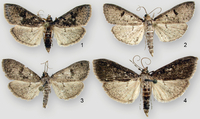Identification
Adult Markings: The following description is from Sullivan and Solis (2013). The labial palps are brown above and white below, while the haustellum is white. The frons is brown with darker, chocolate-colored patches laterally, and the vertex is white centrally with brown on the sides. The antenna is brown dorsally and tan ventrally, with the scape brown and the pedicel brown with white scales at the base. The thorax is fuscous, while the first two abdominal segments have white scaling dorsally, and fuscous and chocolate scaling laterally. The remaining abdominal segments are chocolate colored dorsally with scattered fuscous scales covering most of the segment. There is also a row of white scales distally, which gives the abdomen a ringed appearance. The terminal segment is largely fuscous, and the abdomen extends one-third the length beyond the wing margins. P. maritima is usually uniform and continuous, while the terminal line on one or both wings of P. freemanalis and P. arsaltealis is broken into a series of dark spots. Sullivan and Solis (2013) noted that genitalia provide the most reliable way to distinguish among these species, but specimens that have both wings with a continuous terminal line can reliably be assigned to P. maritima .
Wingspan: 29 mm (Sullivan and Solis, 2013).Forewing Length: 12 mm (Sullivan and Solis, 2013).
Adult Structural Features: Sullivan and Solis (2013) provide detailed descriptions and illustrations of the male and female genitalia. The male characters, especially the shield-like juxta with two posterior pointed projections, and the medial ribbon-like sclerotization across the valva, are diagnostic.
Genitalia and other structural photos
Adult ID Requirements: Identifiable only by close inspection of structural features or by DNA analysis.
Immatures and Development: The larval life history is undocumented.

 »
»


 »
»
